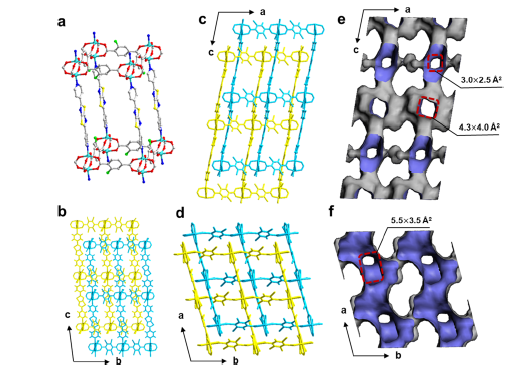
发表论文

Doubly Interpenetrated Metal−Organic Framework of pcu Topology for Selective Separation of Propyle...

2021-03-03

53
Ting Liu, Hui Cui, Xin Zhang,* Zhi-Yin Zhang, Rui-Biao Lin, Bin Liang, Jian Zhang, Dan Li,* and Banglin Chen*ABSTRACT: Adsorptive separation is an app...
查看更多 >
2020-03-22
Exceptionally water stable heterometallic gyroidal MOFs: tuning the porosity and hydrophobicity by doping metal ions


47次浏览
Xiao-Wei Zhu, Xiao-Ping Zhou, and Dan Li*Abstract:A strategy to improve the framework porosity and hydrophobicity of the pore surface by doping metal ions (Cu2+, Cd2+, or Fe2+) into a gyroidal MOF STU-1 has been developed. It is found that the obtained heterometallic MOFs are exceptionally water stable.文章链接:C6CC02116F.pdf
>
2020-03-22
极长与极短的铜铜距离-吡唑环三核亚铜配合物亲铜作用本质及发光调控


27次浏览
郑霁,邢立锐,李丹*摘要:本文结合近年来亲金属作用研究领域的进展,针对本课题组在环三核亚铜配合物方面的最新研究成果讨论了两个铜(I)–铜(I)作用相差悬殊的体系。一是通过构筑具有环三核单元的三棱柱笼状配合物,确认在正堆积模式下即使环三核单元之间亲铜作用极弱依然可以在磷光发射态中产生强亲铜作用,且通过配体的预留配位点与Cu2I2簇连结从而得到自校准大范围发光温度计;二是通过与亲铜作用正交的Br―Br卤键,实现环三核亚铜配合物前所未有的极短铜(I)–铜(I)距离,通过各种电子结构分析方法研究其本质。结果表明即使当铜(I)–铜(I)距离很接近铜的范德华半径和时,其本质依然为闭壳层作用,而Br―Br作用总为闭壳层作用,且该体系中最强的Br―Br作用很好地体现出一个Br原子的σ穴和另一个Br原子的负静电势区域的匹配性。关键词:亲铜作用;正堆积;磷光发射态;卤键;约化密度梯度;分子中的原子的量子理论文章链接:PKU.WHXB201706051.pdf
>
2020-03-22
Structure- and Temperature-Dependent Luminescence Properties of Threefold Interpenetrated Networks: Coordination Polymers Based on Dinuclear Gridlike Silver(I) Units


31次浏览
Shun-Ze Zhan,* Huan-Quan Song, Liu-Jun Guo, Raymond Wai-Yin Sun, and Dan Li*Abstract:Dinuclear gridlike AgI structural units (1) based on(3-pyridyl)-5-R-pyrazole ligands are extended from ligomers(R = phenyl) to three threefold interpenetrated 3D coordinationpolymers (R = 3-pyridyl) with cds-a (augmented CdSO4) networks(2-NO3, 2-ClO4, 2-BF4) linked through multiple supramoleculainteractions (Ag–ligand, Ag–anion, Ag···Ag, and π–π interactions). The photoemission intensities of 2-NO3, 2-ClO4,and 2
>
2020-03-22
From helix to helical pores: solid-state crystalline conversions triggered by gas–solid reactions


24次浏览
Jie Liu,⊥Jia-Jia Du,⊥Yuan Wu, Yi-Fang Zhao, Xiao-Ping Zhou,* and Dan Li* Abstract:Two one-dimensional (1D) helical coordination polymers, CuBIm–Cl and CuBIm–Br (BIm = 1,2-bis((5H-imidazol-4-yl)-methylene)hydrazine), are constructed from Cu2+ ions, halides and mono-deprotonated BIm. Solid-state crystalline conversions of CuBIm–Cl and CuBIm–Br to a gyroidal metal–organic framework (MOF) STU-3 which is composed of Cu ions and Bim ligands are observed through a gas–solid reaction, where the gas is m
>
2020-03-22
A highly emissive and stable zinc(II) metal–organic framework as a host–guest chemopalette for approaching white-light-emission


35次浏览
Hong Cai, Li-Li Xu, He-Yun Lai, Jing-Yi Liu,b Seik Weng Ng and Dan Li *Abstract:A new adenine-containing metal–organic framework (MOF), [Zn4O-(adenine)4(benzene-1,3-dicarboxylate)4Zn2] (named as ZnBDCA), was synthesized solvothermally. ZnBDCA possesses high quantum yield (450%) and nano-channels that can encapsulate acriflavine molecules to build a host–guest chemopalette for approaching white-light emission.文章链接:c7cc03350h.pdf
>
2020-03-22
Solvent-Assisted Metal Metathesis: A Highly Efficient and Versatile Route towards Synthetically Demanding Chromium Metal–Organic Frameworks


39次浏览
Jun-Hao Wang,* Ying Zhang, Mian Li, Shu Yan, Dan Li, and Xian-Ming Zhang*Abstract:Chromium(III)-based metal–organic frameworks (Cr-MOFs) are very attractive in a wide range of investigations because of their robustness and high porosity. However, reports on Cr-MOFs are scarce owing to the difficulties in their direct synthesis. Recently developed postsynthetic routes to obtain Cr-MOFs suffered from complicated procedures and a lack of general applicability. Herein, we report a highly efficient a
>




